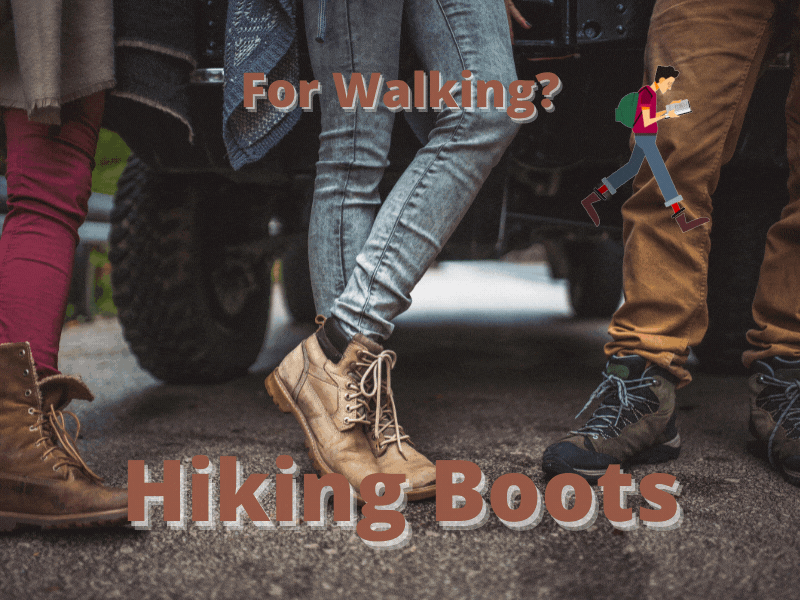I have some hiking boots that I use when hiking on trails but I also use them to walk around in after I’m done. I go walking around stores and around the house to get my daily activities accomplished before taking them off.
Hiking shoes can work well for walking long distances because they are very supportive and help the wearer reduce the amount of work needed to be done by their feet. Lightweight boots are usually used when walking off-trail because they feel more comfortable, light, and usually breathe better.
There are a wide variety of hiking shoes to choose from and some of them are similar to walking shoes in many ways. A traditional hiking shoe is meant to help with heavy load and foot stability, and some walkers might find these attributes fit their needs just right. Continue reading to find how to find the best hiking shoe for walking.
Having good hiking boots can make all the difference for comfort and durability. As you walk your time on the road, sidewalk, or around town, will be more enjoyable. Choosing the one best for you can take some research about various boots and your own needs.
Hiking boots alone can easily be the difference between a great walking experience and a bad one.
So what should we look for?
In this guide, we’ll tell you exactly how to choose a hiking boot, so that the next time you go for a walk you’ll likely have a good experience.
How to Choose a Walking Hiking Boot
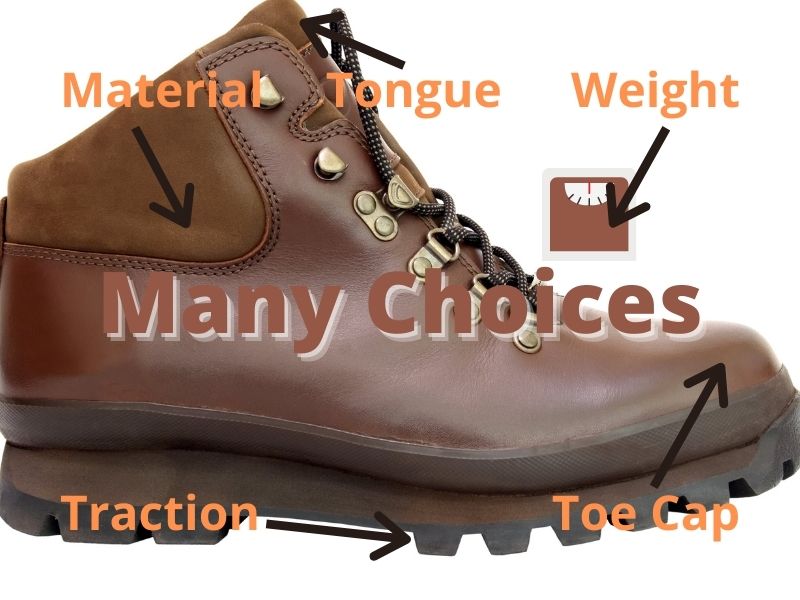
If you’re shopping around for the right pair of walking hiking boots, you’ll likely want one that is similar to a walking shoe or one that is a comfortable yet robust hiking boot. First, you’ll need to think about the boot weight.
Weight
Each boot is likely to weigh anywhere from ~13oz to 26oz. The weight of a boot will definitely have an effect on how tired you are the more you walk. So the first thing to figure out is how long will you regularly be using your boots for walking.
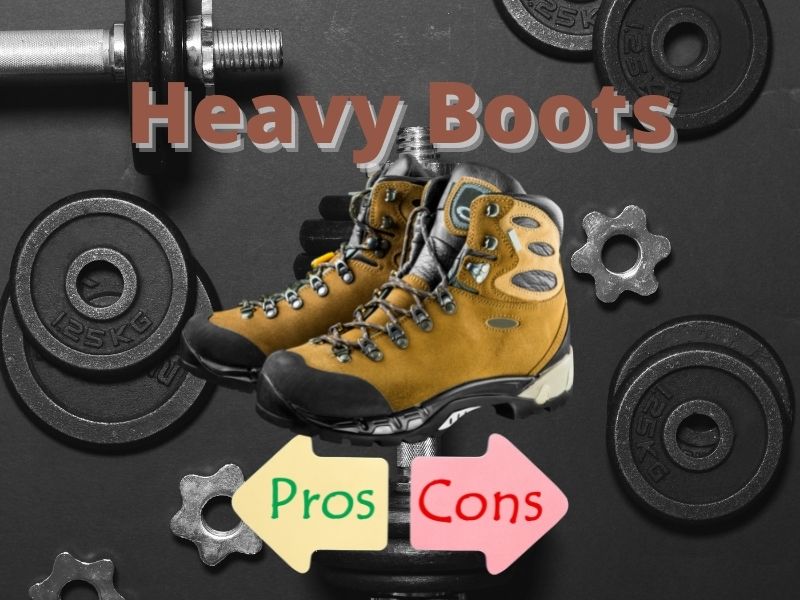
PROS
- They possibly provided better ankle support
- They protect feet from obstacles -rocks/shrubs
- They can be waterproof/snowproof
- Multipurpose use – Long treks or neighborhood walk
- Many have long durability
- Good for heavier people and heavier pack weight
CONS
- They may tire you quicker
- They are not very flexibles (may decease mobility/ may cause tripping)
- They take some time to break
- They don’t usually breathe well
The cons of heavier boots tend to make some people look for other options. Luckily there are many low-weight hiking boots you can choose from. They offer similar attributes to heavier boots with some differences.
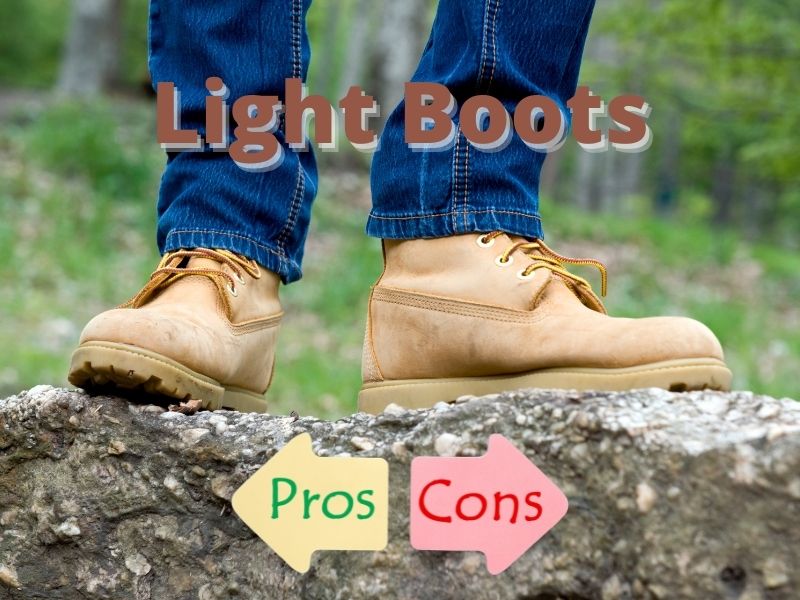
PROS
- They are more nimble (possibly prevent injury better)
- They protect feet from obstacles -rocks/shrubs
- They can breathe better
- They are more flexible for stronger feet and less to no break-in period
- They tend to be more comfortable and soft
- They can be water repellent
- They tire you less
CONS
- They may not be as durable
- They are not good for heavier people with heavy packs
- The foam midsole may be too thin for climbing over rocks for long periods
- They don’t usually breathe well
As I have watched many YouTube videos and read articles about hiking, most people like lighter hiking boots. They like that they are lightweight, nibble, and comfortable. I think they are better for your feet in general if you have a backpack that isn’t too heavy.
Whichever weight your boot is may have an impact on how much walking you do and how easy it is for you. Decide which factors are most important for you and choose a boot that matches those criteria best. I would choose a lighter hiking boot with a flexible sole if I was doing a lot of walking with them.
Material
The materials used in a boot may matter when it comes to your boot’s longevity and comfort, How it feels and how long it lasts may determine if you decide to buy it.
The material you choose to go for can have a big impact on how effective your shoe is when dealing with
water/moisture, how much it weighs, as well as how durable and hard-wearing it is.
Most people want a shoe that breathes well when walking. If your boots have mesh and breathe well you will likely be happier on your walks with these types of boots.
Soles
Although hiking boots nearly always have soles made from rubber, how well the boot actually grips the ground can vary greatly from boot to boot.
I have both looked at reviews and tried on the boot myself to see if they have the grip I’m looking for. Some boots may have special soles such as Vibram that last a long time, while others have propriety sole types that offer varying levels of grip.
The better the grip the more likely your boot will be helpful during most walking and hiking conditions. If your sole is flexible you will have an easier time walking and your boots will probably feel more comfortable too. The only problem that occurs is if your sole tread is very nobby it might feel uncomfortable on flat cement sidewalks.
Nubuck and Suede
Although more comfortable than full-grain leather, the downside is that it’s not quite as hardwearing, and
doesn’t offer as much water resistance.
You can add a waterproofing spray (see article) to your shoes and it won’t add any weight but can still allow the leather to breathe.
Although, because suede Leather is sanded it doesn’t breathe that well and may get hot. If you’re walking a lot, decide which boots fit the weather conditions you’ll be walking in most.
Full-Grain Leather
This type of leather is extremely durable, and also has fantastic water-resistant properties. However, it’s very heavy. It should breathe well unless the pores are clogged with dirt and oils. Try to clean it every so often and then condition the shoe to get the best results for soft leather and breathability.
Then walking in your full-grain leather boots should be fairly comfortable depending on the soles you have.
Synthetics
This covers a range of materials, such as nylon, polyester, polyurethane and more. Synthetics are often
designed to imitate the good qualities of other, natural materials such as leather, wool, or
cotton.
Sometimes these materials work well but sometimes they don’t work well. Synthetics tend to be lighter, more moisture-resistant, and more flexible.
If you get a boot that is mostly synthetic, this could work well, just remember to invest the time into finding a good quality boot.
Waterproof Membrane
These are often placed between the outer and inner layers of hiking boots, in order to form a waterproof
barrier. These shoes are the least likely to be comfortable when walking because they can trap moisture in your shoe.
Some waterproof boots can breathe, but many aren’t as breathable as a leather or a partial mesh upper boot.
Mesh
More common in sports trainers than hiking boots, this is extremely breathable, but offers very little water resistance, and may also be prone to tearing or breaking.
If you walking in mesh boots you can expect to have so good air flow making your foot more comfortable.
Toe Cap
A toe cap is a bumper that’s placed at the toe of the boot that acts as a shield against sudden
impacts. These are usually made of hardened rubber or plastic, and can sometimes be found on the heel
or sides of the boot as well.
These can make a boot hard to walk in for long unless the insole is very comfortable and there’s plenty of padding inside the shoe.
Gusseted Tongues
A gusseted tongue is a type of tongue that’s attached to the upper section of the boot. This prevents dirt,
grit, and gravel from getting inside, to keep your feet comfortable.
While these are good for the trail, they might make your shoe a bit less breathable. So check to see how well your foot can breathe in the boot first if you will be walking in them a lot.
Traction
Traction is extremely important, especially when traversing challenging terrain, as this will prevent you
from slipping over, and help reduce the risk of injury.
Understanding a hiking boot’s lugs (the tread on the bottom – like on a car tire) will give you an
indication of what terrain they’ll be best suited for. Wide, shallow lugs are better suited for a smoother
terrain and walking, whereas deeper and narrow lugs offer better traction in harsher, uneven terrains.
Different sized and shaped lugs also work differently in wetter or drier conditions too. It’s important to get
the balance between something that’s efficient, but also gives you stability when tacking different parts of
the trail.
Why Should You Wear Hiking Boots?
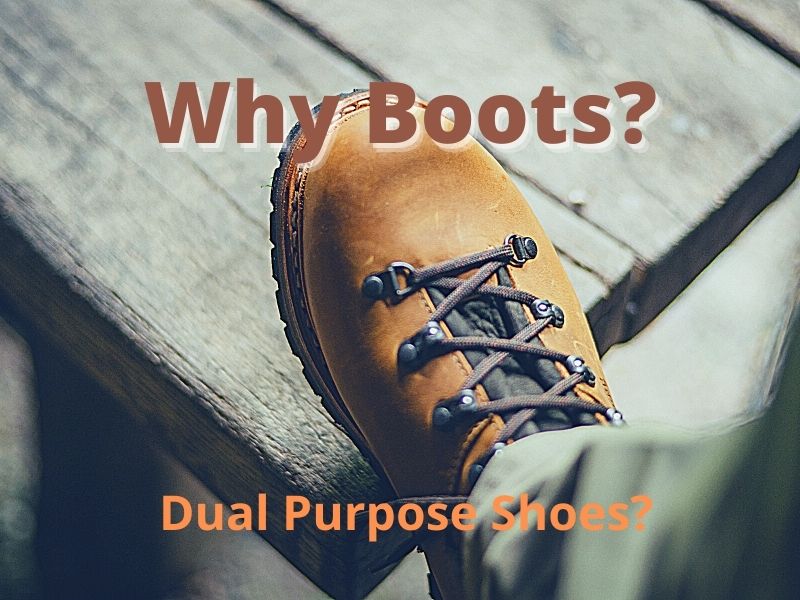
There are various reasons why you might want to choose a hiking boot when walking. One reason might be you want to slowly progress from walking on the sidewalk to walking on more difficult trails.
Experienced hikers know that a good pair of boots can offer the perfect balance between something that’s
lightweight, durable, water-resistant, and tough enough to resist tears and scratches in rough terrain.
If you know you will be going on the trail quite often, then getting a boot to walk in first once in a while can help your feet and legs get used to them slowly over time.
That way your feet won’t hurt once you start wearing them on the trail because they are already used to them.
Having heavy footwear can really sap your energy when hiking, but it’s also important to have something
that can provide you with adequate support, to avoid any potential injuries or falls.
Although hiking boots are often heavier than trainers, or minimal hiking-based shoes, they can also be fairly lightweight. For some, they can provide a bit of stability, and protection. In short, some hiking boots can be an all-around shoe for walking and hiking.
Types of Hiking Boots
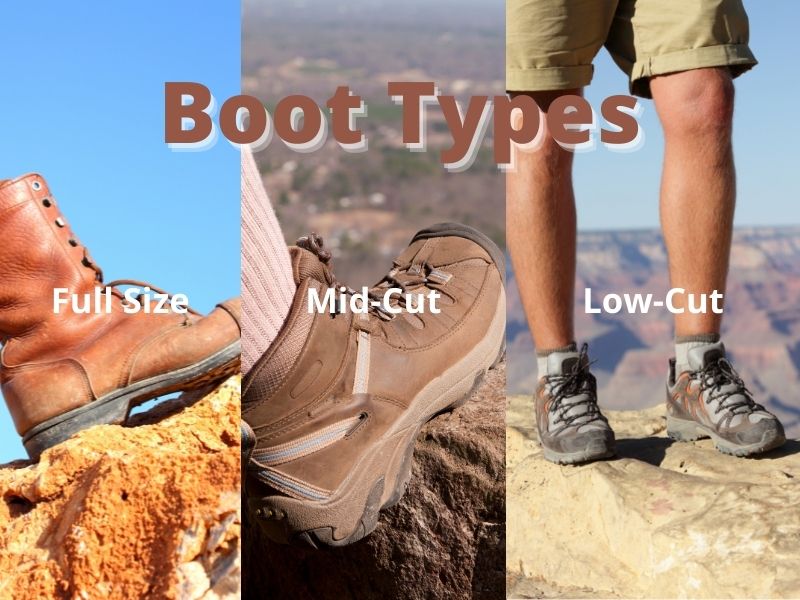
Here are the main types of hiking boots
Hiking Shoes
Some hiking boots are low-cut, giving them a more casual and minimal look and feel. Although they may
not offer as much support as high-rising hiking boots, it might not matter based on the evidence from studies that have been made.
This could be a great alternative to a boot and still give you the features you need. Many of these tend to have more flexible soles although not all.
Day Hiking Boots
Day hiking boots tend to lie somewhere in between normal hiking boots and hiking shoes and are often
mid-cut, meaning that they’re higher than the ankles, but don’t rise much above the bottom of the shin.
These are ideal for slightly longer hikes. They’re also a good idea if you’re carrying a backpack, as the extra weight you’re carrying will require some added support.
Backpacking Boots
Backpacking boots are designed for longer trips – often spanning multiple days – and are also suitable for
carrying heavier loads.
Because of this, they offer fantastic support, and are ultra-durable and hardwearing, making them suitable
for even the most unforgiving terrains. Ideal for those wild adventures in the mountains, or those multi-day hikes in varied landscapes.
What Are the Advantages of Hiking Boots?
Despite them often being heavier and slightly more clunky than other shoes – such as trainers, or minimal
shoes – the main advantages of hiking boots lies within the protection they offer. Hiking boots offer
optimal protection against bumps into rocks and sticks, slips, falls, and they’re usually ultra-tough.
The material used in their design also makes them great for different temperatures, landscapes, weather
conditions, and more.
Although other footwear can be worn in more tame and predictable conditions, for
those obstacle-heavy trails, uneven craggy rocks, or wet and sludgy conditions, hiking boots are the best
way to ensure that your feet will stay safe, comfortable, and dry the entire time.
Be aware that if you are crossing streams over a couple of inches or it’s raining a lot then your hiking boots may get soaked. Then you would do better with a lightweight mesh trail runner if you aren’t carrying much.
Although hiking boots used to be a lot clunkier, some manufacturers have been able to make some
efficient modern designs, that are surprisingly lightweight and comfortable. They also offer a range of
colors, styles, and sizing adjustments, allowing you to make them perfect for you – both in the way they
look and the way they fit!
How to Fit Hiking Boots

If you feel you know enough about hiking boots – their various materials, uses, properties, etc. – then
you’re ready to try on some for yourself.
The best way to do this is to go to your local outdoor store, or retailer, and try them on in person.
Alternatively, you can measure up your feet at home and buy a pair online instead.
Get Your Hiking Boots in the Right Size
You can either get your feet measured professionally in-store, or you can measure your feet at home
yourself. It’s important to re-measure your feet for hiking boots, rather than assuming you’ll be the same
size as you are for all your other shoes, as hiking boots will fit differently, and you’ll most likely be wearing
different socks than you do when wearing your normal shoes.
When measuring your feet, it’s best to do this standing up as this is more accurate than what you’ll be doing
when wearing hiking boots. Bear in mind though that sizes can vary greatly between brands.
Keep in Mind the Shape of Your Feet
Not only do feet differ in length, but they also differ greatly in width. Some people have narrower feet,
that struggle to reach the sides of their shoes or boots, whilst others have wider feet and need their
footwear to accommodate this.
In short, you’re unlikely to be the same ‘shoe size’ in all shoe types or brands, so you’ll need your hiking
boots to adhere to this for them to be comfortable and safe.
Put the Hiking Boots On
When trying hiking boots on, it’s important to move – walk around, wiggle your toes, do whatever you
need to imitate what you’ll be using them for.
This will give you a more accurate idea of how they will feel on the trail.
- Make sure to wear the same socks as you would when wearing the boots for real – socks with different thicknesses can have a big impact on the overall fit.
- Consider trying boots on in the afternoon or evening, as your feet will usually swell throughout the day, so this will give a more accurate-to-life fit.
- Always put both shoes on – your feet aren’t perfectly symmetrical, so just because your left foot fits well, doesn’t mean your right will too!
- Walk up and down – slopes, stairs, ramps, whatever can imitate the different terrains you might be walking in. Make sure when walking that the boots don’t tug too much on your toes or heels, as this could create blisters after prolonged use.
- Your foot should always feel secure in the boot, regardless of the surface, you’re walking on.
- Consider buying insoles to add padding inside, as this can also reduce discomfort when hiking over long distances.
How to Break in Your New Hiking Boots
Although many manufacturers design their boots to be worn the moment you buy them, some still need
to be ‘broken in’ or ‘worn in’.
Remember that if a shoe doesn’t feel comfortable when you put them on, it may never feel comfortable. So find ones that are comfortable.
Some shoes do form around your feet a bit. This will allow your feet to feel more comfortable over time. The material of the boot may flex to accommodate your foot shape, at least a little.
You should aim to wear them for at least an hour in total (broken up into small chunks), before heading
out on the trail for a long walk. If any irritation caused doesn’t go away over time, then the boots might
just be a bad fit.
Important Hiking Boot Accessories
Here are a few accessories you should consider getting:
Insoles
Insoles sit inside your boot and are what your socks are in contact with. They vary in material, thickness and texture, but are designed to add comfort and warmth, as well as wick away any excess moisture, to ensure that your feet feel comfortable and dry. Some are also designed for hygiene reasons and include antibacterial properties.
Gaiters
Gaiters are small cuff-like covers that wrap around your lower shin. They prevent dirt, grit, and rain from
getting into the boots, so they remain comfortable throughout your hike. Although they might not be
necessary, in certain conditions they can make a huge difference to your overall experience, so they might
be worth picking up.
Final Thoughts
Although there seems to be an almost unlimited number of things to consider when choosing the right
hiking boot, if you should be able to walk with most hiking boots and be fine.
Aim to get a pair of boots that are comfortable when walking on the sidewalk and trail or if you have boots already make sure your feet are ready by going on short walks until your feet get used to them.
As you take your time to find the pair that’s just right for you you’ll be glad you did if they turn out to be perfect for what you want.
Thanks for visiting Helpshoe.com

